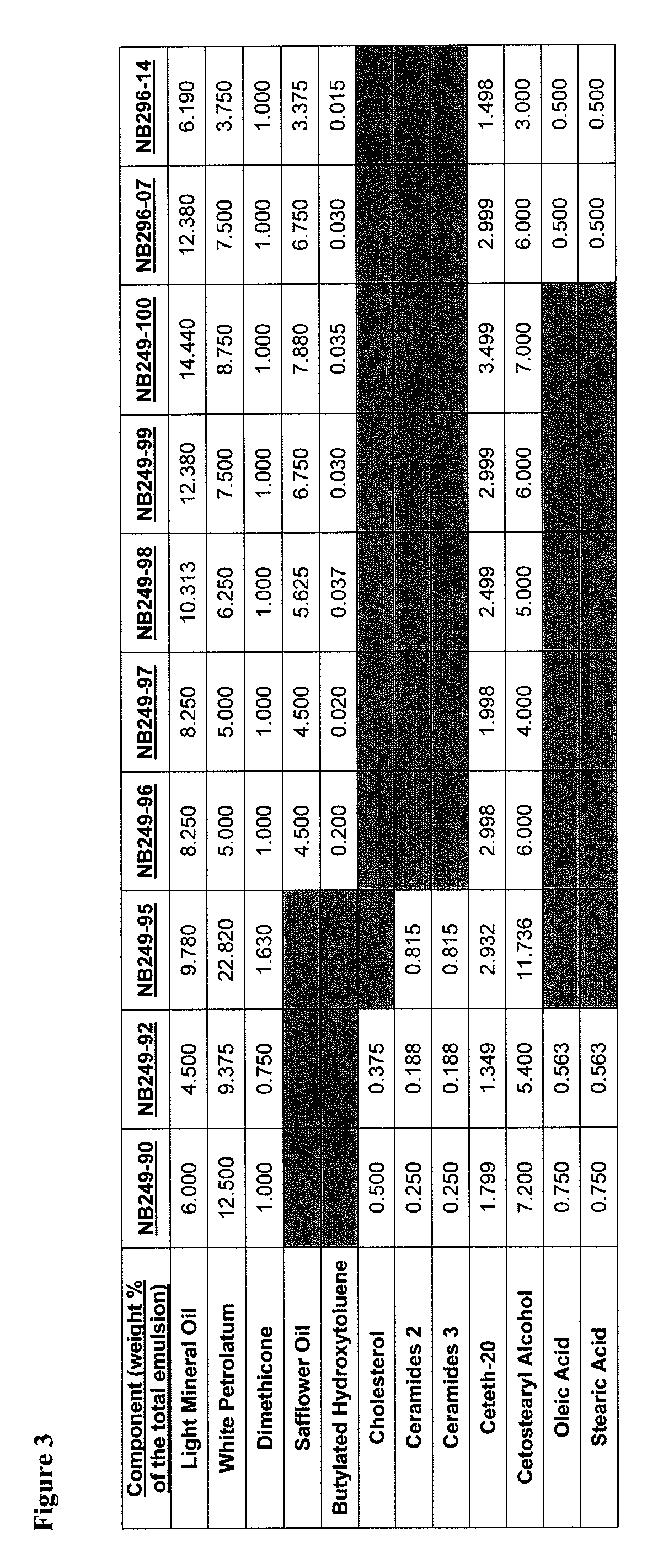High oil-content emollient aerosol foam compositions
a technology of aerosol foam and emollient, which is applied in the direction of extracellular fluid disorder, immunological disorder, metabolism disorder, etc., can solve the problems of narrow dosage range of active agents, limited number of active ingredients, and excessive water loss
- Summary
- Abstract
- Description
- Claims
- Application Information
AI Technical Summary
Benefits of technology
Problems solved by technology
Method used
Image
Examples
example 1
Compositions and Method of Manufacture
[0897]An example product concentrate (NB249-99) can be manufactured by the procedure outlined below:
[0898]Part A: Oil Phase Preparation[0899]1. Charge Ceteth-20 (I) light mineral oil, white petrolatum, dimethicone, safflower oil, butylated hydroxytoluene and cetostearyl alcohol into a stainless steel tank and heat until fully melted.
[0900]Part B: Aqueous Phase Preparation[0901]1. Charge Purified Water (I) and Glycerin into a stainless steel tank and heat to 75-80° C.[0902]2. Charge and dissolve citric acid (I) and sodium citrate (I) as well as urea, methyl paraben and propyl paraben while mixing.[0903]3. Continue mixing until a clear solution is obtained while maintaining a temperature of 65-95° C.
[0904]Part C: Drug Phase Preparation[0905]1. Charge a Stainless Steel tank with Purified Water (II), citric acid (II), sodium citrate (II) and Ceteth-20 (II).[0906]2. Mix slowly at room temperature to dissolve.[0907]3. Add hydrocortisone butyrate and m...
example 2
Active Ingredients
[0920]In addition to the corticosteroid hydrocortisone butyrate, other corticosteroid active ingredients can be incorporated into the compositions of the invention. Other classes of active ingredients may also be incorporated into the compositions of the invention including vitamin-D analogs, retinoids, immunomodulators, antifungals and combinations of these active ingredients with each other or with corticosteroids. The example emulsions depicted in FIG. 4 were prepared as described in Example 1.
example 3
Emulsion Viscosities
[0921]Vehicle viscosity influences the ability of the emulsion to hold an active pharmaceutical ingredient (API) in suspension, the physical stability of the emulsion, and the density, delivery rate, and delivered amount of dispensed foam. Low formulation viscosities allow the API to settle out of suspension, leading to issues of content uniformity and allow the emulsion droplets to segregate in the formulation leading to phase separation. Viscosities above approximately 280,000 cP prevent the composition from moving in the can causing propellant tunneling which leads to inconsistent delivery rate and delivered amount for the dispensed foam. High viscosity also results in a dispensed foam with poor tactile properties.
[0922]The relationship between oil phase composition and viscosity was examined. In topical formulations, the co-surfactant cetostearyl alcohol builds viscosity and foam density. Oil phase concentration and components also influence drug product visc...
PUM
| Property | Measurement | Unit |
|---|---|---|
| density | aaaaa | aaaaa |
| density | aaaaa | aaaaa |
| temperature | aaaaa | aaaaa |
Abstract
Description
Claims
Application Information
 Login to View More
Login to View More - R&D
- Intellectual Property
- Life Sciences
- Materials
- Tech Scout
- Unparalleled Data Quality
- Higher Quality Content
- 60% Fewer Hallucinations
Browse by: Latest US Patents, China's latest patents, Technical Efficacy Thesaurus, Application Domain, Technology Topic, Popular Technical Reports.
© 2025 PatSnap. All rights reserved.Legal|Privacy policy|Modern Slavery Act Transparency Statement|Sitemap|About US| Contact US: help@patsnap.com



